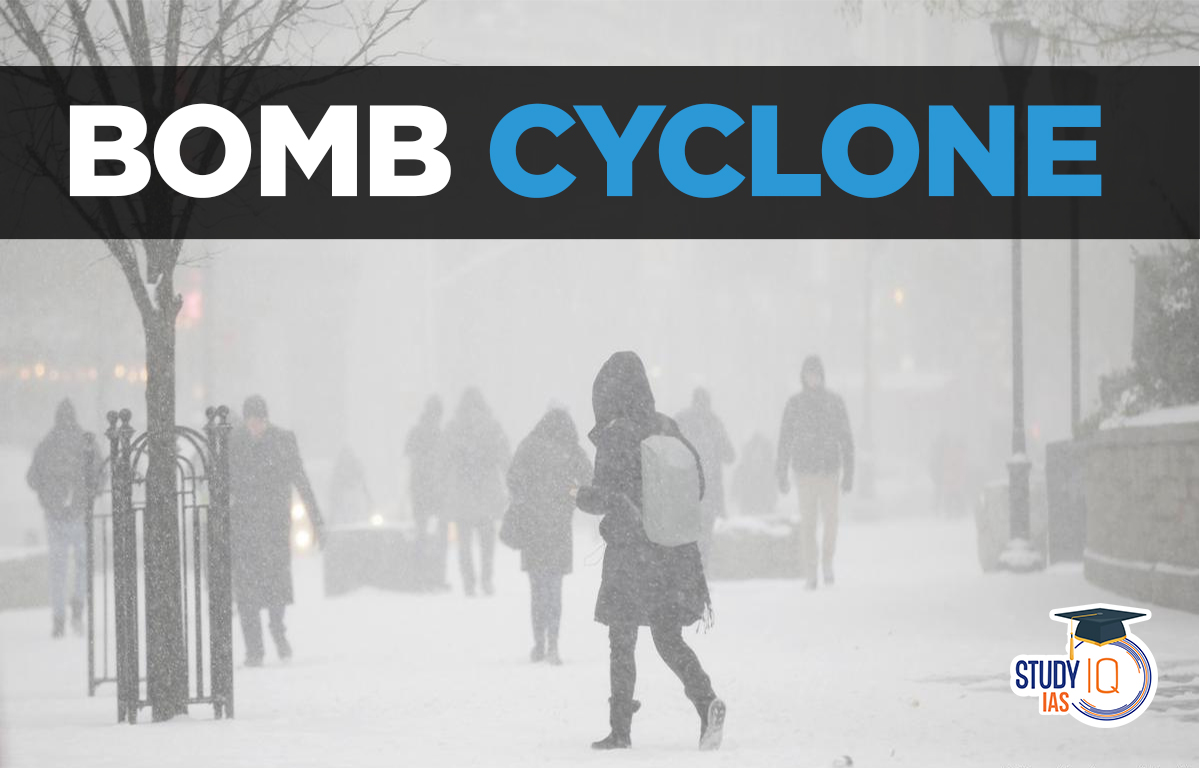Table of Contents
Context: At least 17 people died, millions are without power and travel disrupted as record-breaking cold gripped the USA due to bomb cyclone.
What is a Bomb Cyclone?
- Explosive cyclogenesis (also referred to as a weather bomb, bomb cyclone or bombogenesis) is the rapid deepening of an extratropical cyclonic low-pressure area.
- The change in pressure needed to classify a storm as bomb cyclone is latitude dependent. For example, at 60° latitude, bomb cyclone occurs if the central pressure decreases by 24 mbar (hPa) or more in 24 hours.
About Cyclones
- Cyclones are rapid inward air circulation around a low-pressure area whereas anti-cyclones are circulation of winds around a high-pressure area.
| Pressure system | Pressure condition at the centre | Pattern of wind direction | ||
| Northern Hemisphere | Southern Hemisphere | |||
| Cyclone | Low | Anticlockwise | Clockwise | |
| Anti-cyclone | High | Clockwise | Anticlockwise | |
- Types: There are two types of cyclones.
- Tropical cyclones (also called typhoon or hurricane, an intense circular storm that originates over warm tropical oceans).
- Extra Tropical cyclones (also called temperate cyclones or middle latitude cyclones or Frontal cyclones or Wave Cyclones).
Characteristics of Bomb Cyclone
- Bomb cyclone is a predominantly maritime, winter event, but also occurs in continental settings, even in the summer.
- It can produce winds of 120 to 155 km/h, and yield heavy precipitation.
- It is characterized by cold winds, which are also expected to pick up, and temperatures could drop far below zero — enough to cause frostbite within minutes.
- This process is the extratropical equivalent of the tropical rapid intensification (It is a situation where a tropical cyclone intensifies dramatically in a short period of time).
- Formation: The mechanism of formation of a bomb cyclone is similar to that of an extra-tropical cyclone. However, the rapid drop in pressure leads to bombogenesis.

- Factors responsible for the rapid drop in pressure during bombogenesis:
- Baroclinic instability and adiabatic processes are the principal factors.
- Other factors include the relative position of a 500-hPa trough, deep tropospheric frontogenetic processes, the influence of air–sea interaction, and latent heat release.
- Most affected regions: The four most active regions where extratropical bomb cyclones occurs are:
- The Northwest Pacific,
- The North Atlantic,
- The Southwest Pacific, and
- The South Atlantic.
- Similarity with hurricanes: Though bomb cyclones share characteristics with hurricanes, they are not hurricanes:
- Bomb cyclones have cold air and fronts: Cold air rapidly weakens hurricanes, while it is an essential ingredient for bomb cyclones.
- Bomb cyclones form during winter: Hurricanes form from late spring to early fall, while bomb cyclones form from late fall to early spring.
- Bomb cyclones form at higher latitudes: Hurricanes form in tropical waters, while bomb cyclones form over the northwestern Atlantic, northwestern Pacific and sometimes the Mediterranean Sea.
Tropical Cyclones
- A tropical cyclone is a warm-core, low pressure system without any “front” attached, that develops over the tropical or subtropical waters, and has an organized circulation.



 DRDO and Air Force Successfully Test Ind...
DRDO and Air Force Successfully Test Ind...
 IB ACIO Recruitment 2025 Notification Ou...
IB ACIO Recruitment 2025 Notification Ou...





















